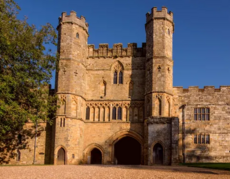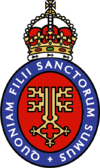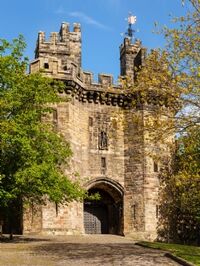Parliament of Great Nortend
Parliament of Great Nortend The High Court of the Parliament Parlamentum Curiæ Regis | |
|---|---|
| 5th Alexandri Regi | |
 King's Entrance | |
 Emblem | |
| Type | |
| Type | Tricameral |
| Houses |
|
| Leadership | |
Lord High Steuard | The Count of Barminster |
Lord High Chancellour | The Bishop of Chepingstow |
Sir Spencer de Stornton, Scodeliers | |
Speaker of Knights | Sir Peter Faulkner |
Knight-Lieutenant | Henry Wigham |
| Structure | |
| Seats |
|
Commons parties |
Scodeliers (96) Conservatives (86) Droughers (131) Plines (8) Military (2)
|
| Meeting place | |
| Castle of Lerdenstone | |
The High Court of the Parliament, known in Court Latin as the Parlamentum Curiæ Regis, is the main legislative body in Great Nortend. The Parliament consists of the King in Common Council, the House of Lords, comprising the nobility and prelates of the Realm, the House of Proctors, comprising the churchmen, and the House of Commons, comprising the burgesses and yeomen. The Parliament meets in the Castle of Lerdenstone in Lendert-with-Cadell.
Houses
The three houses of Parliament are the House of Lords, the House of Clerks and the House of Knights.
House of Lords
The House of Lords comprises Church of Nortend prelates, being all cardinals, bishops, abbots and priors, and the peers of the Realm—the princes, dukes, counts and barons. It is the most senior house of Parliament, and its composition is at the conventional discretion of the Sovereign who sends named writs of summonitione parlamenti to each lord individually. The House of Lords typically sits in the Quire of the Chapel of St Giles Within.
Houses of Clerks
The Houses of Clerks includes the lesser church dignitaries, including deans, provosts and archdeacons. It also includes the proctors, elected to represent the rectors of each diocese as well as special constituencies as the Universities.
Houses of Knights
The Houses of Knights comprise of representatives of the laity, including aldermen and yeomen. They are directly elected by the people. Each shire (or shire division) elects two yeomen to Parliament, whilst each borough or city elects between one and three aldermen. The House of Knights sit in the Knights' Hall.
Procedure
Each house of the Parliament has a presiding officer. In the case of the House of Lords, the presiding officer is the Lord High Steuard with the Lord High Chancellour as deputy. The two offices of state are ex officio, and held by the Count of Barminster and the Bishop of Chepingstow, as he may be from time to time.
The presiding officer of the House of Knights is known as the Knight Speaker. The deputy officer of the House of Knights is the Knight Lieutenant. The Speaker and Lieutenant are, currently, Peter Faulkner, Alderman for Mainrew, and Henry Wigham, Yeoman for Swent North East.
The presiding officer of the House of Proctors is known as the Prolocutor, who is the Dean of St. Giles, currently the Rev'd. John Wenland. The deputy officer is the Junior Prolocutor.
The presiding officer is charged with maintaining the standards of their house, and to enforce the rules and regulations as set out in the standing orders. The presiding officer for the Houses of Commons are elected from their members, and are usually taken from the party or faction in Government. All three houses use oral voting to determine motions put to the house by the presiding officer, with the option of a Division.
Legislation
Bills for legislation must begin in the House of Lords, where it is introduced by either a prelate (in the case of a Canon) or a peer (in the case of a Statute). The principal difference between a Statute and a Canon is their sole cognisance in the secular and ecclesiastical courts respectively, and thus touch on the jurisdiction of between State and Church under the King as Sovereign. Upon the consent of the House of Lords, the bill is then sent to the relevant lower house for debate, amendment and approval by the Commons, before returning to the House of Lords for consideration of any amendments, followed by presentation for Assent.
It is a constitutional principle that only the consent of the Lords is formally needed for any Act, as bills are presented to the King by the Lord Steuard on behalf of the House of Lords. However, it is very rare that any legislation is passed without the approval of either the House of Knights or the House of Clerks.[1]
Assentus Regis
The ceremony of Assentus Regis, or Royal Assent, dates back to the foundation of the Curia Regis in the Destern period. It involves the presentation of a bill to the Sovereign and the grant of assent by him to it.
Its current manifestation is mostly unchanged since the late 18th century, when there was a brief flirtation with the use of English in lieu of Latin by John of Hall; however, Catherine I reverted back to the practice of using Court Latin.
The ceremony begins with the King seated at the Royal Throne in the Chapel of St Giles Within. He is flanked by the Lord High Steuard on his right, as Keeper of the Great Seal of the Realm, and the Clerk Sealer of the Common Council on his left. The Warden of the Case enters the chamber carrying the Case of Chancery wherein a vellum parchment scroll containing the full text of each bill as passed is held, engrossed by the Scrivener Clerks of the Chancery. Each scroll is tied up with ribbon, upon which a short strip of parchment containing the preamble to the bill and a formulaic petition in Court Latin is tied.
The Warden of the Case sets the Case on a table, and presents the first bill to the Sovereign, handing the ribbon and short strip of parchment to the Lord High Steuard. The Lord Steuard reads aloud the preamble and petition, the latter being usually in the form of:—
Ergo, nos humiliter vestrae apprimas majestates rogamus, per et cum illo consilio consentuque dominorum spiritualium et temporalium et regni communium in hoc communi consilio assemblato hodie, ut [Long title of the Bill in Latin] assentiatis et ordinetis ut Magnum Sigillum Regni apponatur.
meaning
Therefore, we humbly beseech your most excellent Majesty, by and with the advice and consent of the Lords spiritual and temporal and the Commons of the Kingdom in this Common Council to-day assembled, that (you) will assent to [the Bill ... ] and ordain that the Great Seal of the Realm be affixed thereunto.
If the King is satisfied to assent to the bill, he says so to the Clerk Sealer of the Common Council, who heats sealing wax pellets above an oil lamp and then pours the molten wax onto a tab attached to the scroll of the bill. The Lord Steuard then, using the Great Seal of the Realm, impresses into the wax the seal, saying as he does the formula, „Ille Rex gratias subjectibus agit et illum vult”, which means, „The King thanketh his subjects and willeth it.”
Elections
Only some members of the House of Knights and the House of Clerks are directly elected. The House of Lords is composed of hereditary peers as the Lords temporal, and bishops, abbots, and priors as Lords Spiritual ex officio their position as prelates of the Church of Nortend. These are elected, but not specifically for parliamentary purposes.
History
With the development of the Royal Household into a state organ with the assumption of greater responsibilities in the beginning of the Destern Period, it soon grew in size and remit that by the 13th and 14th centuries, it began to specialise into various specific offices or departments, such as the the Chancery, which was responsible for producing official documents and writs, the Wardrobe, with responsibility for the royal accounts, the Treasury, with responsibility for the royal treasure, and so on.
Upon the accession of Eltbold in 1268, the Crown gave up its unfettered power to legislate by the swearing to of the Carta Erboniæ Libertatum, which had been sworn to by successive monarchs since 1052 in the reign of Edward I . A new provision was added to the Carta, providing that the King could only enact statutes in certain matters with the consent of his Curia Regis.
From time-to-time, the Kings of Nortend and Cardoby had summoned to their court additional important and learned figures to their courts to advise on how to best govern the Kingdom and to report on the grievances and issues facing his subjects.
Frustrated in his attempts to pass legislation, Charles I, increasingly began to summon all of his barons (rather than only the more powerful) and representatives of the clergy and commoners to his court, to override the increasingly stubborn and rebellious Curia Regis. As assent was obtained them by the vote of all suitours actually present, the increased number of commoner suitours wishing to curry favour with the Crown allowed Charles to enact legislation without breaking his oath.
The additionally summoned group over time began sitting into ad hoc bodies or colloquia, which were summoned by the King to engage in parley to decide which matters to bring to his attention for approval or assent. These meetings began to be known as Parliament, as distinct from meetings of the Commune Consilium (which was a sitting of the entire Curia Regis) or the Privatum Consilium or 'Privy Council' (which were specially selected members of the Curia Regis who privately advised the King).
Hitherto, the Parliament had sat as one body, reconstituted or summoned by writ whenever it was to sit. In 1556, after the accession of George I, the Parliament split into two distinct bodies, with the knights and burgesses sitting by themselves, forming a camera major and camera minor.
Castle of Lerdenstone
The Castle of Lerdenstone is the meeting place of the Parliament, as well as being a Royal castle and administrative centre of the Government, along with the nearby Fettercourt. It is located within the Inner Ward of Lendert-with-Cadell, on a hill known as Lerdenstone Hill. The Castle precincts, within its walls and not including the Castle Gardens, are around 38 acres in size. It has two main entrances, being the King's Entrance and the Commons' Entrance. The King's Entrance is on the south wall on the Calbend, whilst the Commons' Entrance is on Little Ditch Street on the North wall.
Most of the Castle is used for Parliamentary purposes, excepting a number of state rooms and apartments. The main body of the castle dates from between the 12th and 13th centuries as the peripheries of Government of the Curia Regis settled down in the Castle, with major alterations through the years.
Chapel
The chapel of the castle, the Chapel of St Giles Within, is a Gothic royal collegiate chapel in the Church of Nortend dating in its current form to a rebuilding in the 14th century. It is used as the chamber for the House of Lords, which occupies the Quire. Each of the 258 members of the House of Lords is allocated either to one of the 188 choir stalls, or to the 'Form', one of the two long benches. The chapel is still used for daily Mattins, Mass, Nones, Vespers and Vigils, and as a result, the House normally only sits in the afternoon between Nones and Vespers. The chapel has a red and gold colour tone with rich mahogany panelling, ironwork and woodwork with highly elaborate stone carvings, with excellently preserved examples of the original 12th century stained glass.
Commons' Hall
Commons' Hall is a large, double-storied chamber which is used by the two Houses of Commons. It was originally the Library of the Curia Regis, when the Commons sat in the ante-chapel in the Chapel of St Giles Within with the Lords in the quire. Later, when they began to sit independently, it took up residence in the library. The chamber retains its traditional wooden library benches perpendicular to the side walls, facing the speaker's chair, upon which members sit, and also retains shelving on the walls of the hall which currently hold telling copies of most acts currently in force. The chamber has a distinctive blue ceiling and deeply coloured wooden panelling with ornate plasterwork.
This page is written in Erbonian English, which has its own spelling conventions (colour, travelled, centre, realise, instal, sobre, shew, artefact), and some terms that are used in it may be different or absent from other varieties of English. |
- ↑ Indeed, such legislation typically results in motions of protest being passed.



